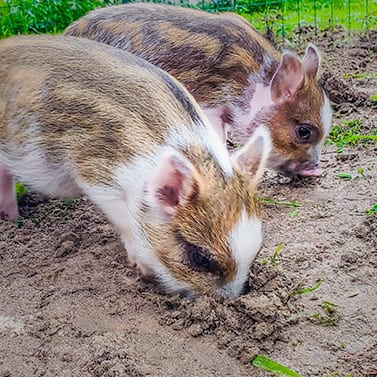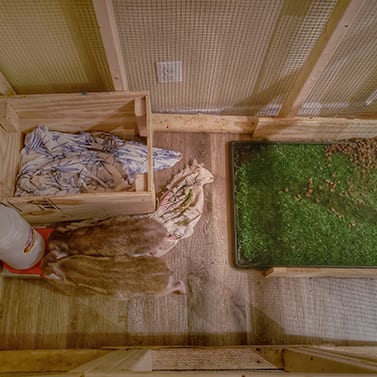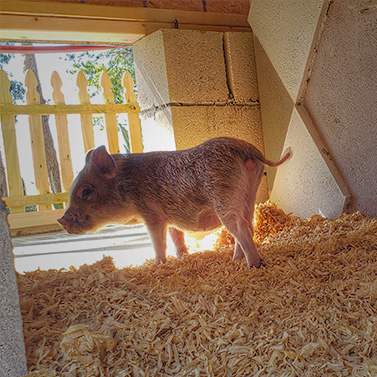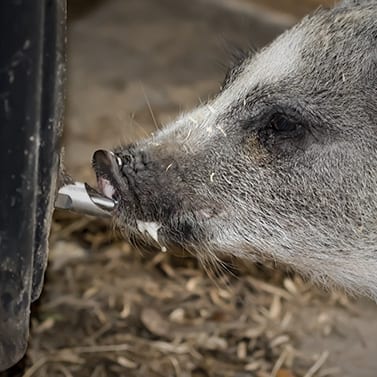Mini Pigs 101: Pet Pig Basics

What is a pig?
pig /piɡ/noun
An omnivorous domesticated hoofed mammal with sparse bristly hair and a flat snout for rooting in the soil. Scientists have determined that not only are pigs intelligent, that they are smarter than dogs, some primates and 3-year old children. They are ranked as the fourth most intelligent creature on earth.
In our opinion have mini-pigs around is a lot of work but also a whole lot of fun. Pigs are very smart animals, similar to dogs and can learn a wide range tasks. They are very curious so it is important to provide a strong and safe enclosure for them when un-supervised.
Mini-Pigs: Getting down and dirty
About Mini Pigs: A comprehensive guide to owning and caring for a mini pig. The page covers a wide range of topics including the history and origin of mini pigs, their physical characteristics, and the specific requirements for their care, feeding, and housing. It also addresses common misconceptions about mini pigs, such as the idea that they are “teacup” sized and can be kept in small spaces. Additionally, we provide tips on training and socializing mini pigs and highlights the importance of finding a reputable breeder or adopting from a rescue organization.
Mini-Pigs do not stay …small
A healthy mini-pig in about 5 years time should weigh between 50 – 150lbs.
It seems as if the majority of us would readily consider their dog or cat companions beloved members of their families. Yet they would eat equally if not more intelligent and lovable animals like pigs.
We all heard the terms mini pig, micro pig, teacup pig and thought how cute these pigs are going to stay small! Well let’s be honest there is NO SUCH thing as a mini pig. These myths are misleading and as a result often pigs will wind up at a shelter or face a worse fate.
Pigs continue to grow until they are 5 years, so thinking your pet mini-pig will remain the same size as when you get him. Don’t buy into this as these animals are sweet and fragile. Too many times we’ve seen people purchase or adopt these pigs just to later re home because they became too big. We are here to educate you on the proper care and information on these amazing, intelligent animals.
10 Interesting facts about Mini Pigs
- Mini pigs, also known as teacup pigs or micro pigs, are a relatively new breed of pigs that were originally bred in the 1980s.
- While mini pigs are smaller than traditional pigs, they can still weigh between 50-150 pounds and grow up to 14-20 inches tall.
- Mini pigs are intelligent and can be trained to perform a variety of tricks, including playing fetch and using a litter box.
- Mini pigs are social animals and thrive on human interaction. They are often kept as pets and can make excellent companions.
- Mini pigs are clean animals and enjoy bathing in water. They are also known to be self-cleaning and will groom themselves like cats.
- Mini pigs are herbivores and enjoy a diet of fresh fruits and vegetables, as well as specially formulated pig food.
- Mini pigs have a lifespan of 12-15 years, which is longer than most other small pets.
- Mini pigs are very agile and can jump over objects that are several feet tall.
- Mini pigs have a keen sense of smell and are often used in law enforcement to sniff out drugs and explosives.
- Despite their small size, mini pigs can be strong and stubborn, and require experienced owners who are knowledgeable about their care and behavior.
Before you add a pig to your family please consider these items:
- Is your area zoned for a livestock animal?
- Do you have time to train, love and socialize with your pig?
- Will your mini-pig(s) be housed inside or outside?
- Do you have adequate shelter for your mini-pig(s)
- Do you have money for proper vet care and supplies?
- Do you have a yard for the pig to root, wallow, graze and explore?
Common Pig Breeds
There are hundreds of pig breeds with a handful of smaller pig breeds which people have as domestic pets.
- Juliana: The Juliana is one of the most popular breeds of mini pigs. They have a small and compact body, and are known for their docile temperament and intelligence.
- Vietnamese Pot-Bellied: The Vietnamese Pot-Bellied pig is another popular mini pig breed. They have a distinctive pot-bellied appearance and are known for their friendly and sociable personalities.
- American Mini Pig: The American Mini Pig is a breed that was developed specifically for the purpose of being a companion animal. They are typically smaller than other breeds of mini pigs, and are known for their affectionate and loyal personalities.
- Göttingen: The Göttingen is a rare breed of mini pig that originated in Germany. They are known for their small size and sweet temperament.
- Yorkshire: The Yorkshire is a breed of mini pig that originated in England. They are known for their friendly and curious personalities, as well as their distinctive black and white coloring.
- Ossabaw Island: The Ossabaw Island pig is a small, feral breed of pig that is native to Ossabaw Island in Georgia. They are known for their hardiness and adaptability, as well as their unique genetic makeup.
Feeding Your Mini-Pig(s)
What should your pet pig be eating?
Under feeding is as dangerous as over feeding. Your pig may always seem to be hungry and may only turn away food when ill.
What you need to know about a proper balanced diet for your little oinker.
“Mini pig” pellets may referred to as pot bellied pig pellets and here are some popular manufacturers: Mazuri, Purina Nature’s Match, Manna Pro and Country Feeds.
Feed for mini-pigs can be purchased any feed supply store or online stores such as Amazon. Serving size is based on the pig’s body weight, but should be adjusted if other meals such as vegetables, grains snacks, fruits or grazing are added in.
Not all pigs are the same and may metabolize food differently. It may take some time to figure out which is the best diet for your pig
Safe Vegetables for Mini-Pigs
- ALL summer & winter squash
- Acorn Squash
- Amaranth
- Arrowroot
- Artichoke
- Arugula
- Asparagus
- Banana Squash
- Bamboo Shoots
- Beets
- Belgian endive
- Bell Peppers
- Black Eyed Peas
- Black olives (fed sparingly due to sodium content)
- Black Radish
- Black Salsify
- Bok choy
- Broccoli
- Brussels sprouts
- Burdock Root
- Butter Lettuce
- Buttercup Squash
- Butternut Squash
- Cabbage & red cabbage
- Carrots
- Cauliflower
- Celery Root
- Celery
- Chayote Squash
- Cherry Tomatoes
- Chickweed
- Chives
- Collard Greens
- Corn (sparingly, there’s enough corn in their pellets already)
- Cucumbers
- Dandelion flower and leaves
- Eggplant
- Endive
- Fava Beans
- Fennel
- Galangal Root
- Green Beans
- Green leaf lettuce
- Green Soybeans (Edamame)
- Jicama
- Kale
- Kohlrabi
- Leeks
- Lettuce
- Lima Beans
- Manoa
- Lettuce
- Mushrooms
- Mustard Greens
- Okra
- Olives
- Parsnips
- Pea Pod
- Peanuts (unsalted)
- Peas
- Plantains
- Pumpkin
- Purple Asparagus
- Radicchio
- Radishes & leaves
- Red clover
- Red Leaf Lettuce
- Rhubarb stem/stalk (the leaves are poisonous and should not be fed)
- Romaine lettuce
- Rutabagas
- Shallots
- Snow Peas
- Sorrel
- Spinach
- Spring Baby Lettuce
- Sugar Snap Peas
- Sweet Dumpling Squash
- Sweet Potatoes
- Swiss chard
- Tomatoes (tomatoes are good but the plant and leaves are poisonous and should not be fed)
- Turnip greens
- Turnips
- Wasabi Root
- Watercress, Winged Beans
- Winter Squash
- Yellow Squash
- Yucca Root
- Zucchini
Safe Fruits for Mini-Pigs
Like most things the food listed as *safe is only applicable if given in moderation. Too much of a good thing can oftem have negative affects on your mini-pigs health.
- Apples NO SEEDS
- Apricots NO PITS
- Bananas & peels
- Bitter Melon
- Blackberries
- Blueberries
- Boysenberries
- Breadfruit
- Cactus Pear
- Cantaloupe
- Cape Gooseberries
- Cherimoya
- Cherries NO PITS
- Clementines
- Coconut
- Crab Apples
- Cranberries fresh or dried
- Dates
- Durian
- Elderberries – Blue
- Elderberries – Purple
- Feijoa
- Figs
- Grapefruit
- Grapes – cut in half or quarter to prevent choking,
- Guava
- Honeydew Melon
- Huckleberries
- Jackfruit
- Kiwi & peels
- Kumquats
- Lemons
- Limes
- Loganberries
- Lychee
- Mango
- Mulberries
- Nectarine NO PITS
- Oranges
- Papayas
- Passion Fruit
- Peaches NO PITS
- Pears NO PITS
- Persimmons
- Pineapple
- Plums NO PITS
- Pomegranate
- Pummel
- Quince
- Raspberries
- Red Banana
- Red Currants
- Sapodillas
- Sharon Fruit
- Star fruit
- Strawberries
- Tangerines
- Thimbleberry
- Watermelon & rind
Grains safe for Mini-Pigs
Amaranth, Barley, Buckwheat, Brown Rice – cooked, Farro, Freekah, Millet, Oats / Oatmeal, Quinoa, Rye, Sorghum / Milo, Teff
Wheat as feed for Mini-Pigs
spelt, emmer, faro, einkorn, durum, bulgur, cracked wheat, wheat berries
Nuts & Seeds for Mini-pigs(UNSALTED)
Almonds, Cashews, Chia Seeds, Cumin Seeds, Brazil Nuts, BOSS- Black Oil Sunflower Seeds, Flax Seeds (in moderation), Grape Seeds, Hazelnuts, Hemp Hearts / Hemp Seeds,Macadamia Nuts, Papaya Seeds,Peanuts, Pecans, Pine Nuts, Pistachios, Pomegranate Seeds, Pumpkin Seeds, Sesame Seeds, Sunflower Seeds, Walnuts, Wheat Germ
Legumes – Must be cooked – NO canned beans
Alfalfa, Black Beans, Black Eyed Peas, Boston Beans, Chick Peas, Fava Beans, Field Peas, Kidney Beans, Lentils, Lima Beans, Mayocoba Beans, Mung Beans, Navy Beans, Pinto Beans, Red Beans, Split Peas
Snacks suggestions for treat dispensing toys
Any assortment of nuts or seeds, Oatmeal, plain & dry, Black Oil Sunflower Seeds, Raisins, Dried Cranberries, Wholegrain Cereals, (Cheerios, Puffed Rice, Shredded Wheat, Bran Flakes
Do not feed your pig items like cake, biscuits, donuts, chips, anything fried or ice cream as these are empty calorie foods and do not assist with proper development.
Building Mini-Pig – Indoor Setup

Your new mini-pig(s) will need to be confined to a small area or space. An option to use especially for traveling would be a crate. You can crate train your piglet the same as you would a dog.
Make sure to keep his/her crate in a separate room away from noise and busy traffic to allow your pig time to adjust and a safe zone for them in the future.
Litter box training is recommended even you do plan on allow your pig outdoor for bathroom breaks and fun time. Training your piggies for litter box is the same as any other animal.
You can place pig feces in the litter box to attract the pig to use the litter box. Make sure the litter box as sides and has traction. Males urinate under their belly, while girls have a stream from the back. Having side can help capture any misses that may occur.
Pigs do tend to eat things and litter may be one of those. Safe litters to use are pine shavings or pellets, paper litters (shredded paper), pee pads, grass pads, or dirt.
Please do not use kitty litter or red cedar as these are dangerous and can cause issues if ingested by the pig.


Building the Outdoor Mini-Pig Enclosure
Since our mini-pigs grew too big to keep inside we moved them outside for a more enjoyable atmosphere. They have a fenced in area using sheep fence from our local livestock supply store. This ensures a safe play area for them to root, explore, sunbath or even take a dip in the water pan when it gets too hot.
We installed a misting system on a timer for the warm days we have here in Florida. They also have a automated water bin with nipples to re hydrate as needed. The system uses a float valve directly from a garden hose which keeps a 25 gallon tote with locking lid full with fresh water.
The mini-pigs like to retreat into their hog cabin for bedtime or as needed to get out of the weather elements. Its safely situated under our porch roof, sheltered from wind, rain and sun exposure. We have also insulated it and line it with either stray or hay. You can use thicker shavings as well.
Want to learn more about our outdoor mini-pig pen build? Click the link below to checkout our homestead projects build page.
Spay or Neuter your Mini-Pigs
Getting your piggie fixed is highly recommended for health benefits and to reduce behavioral issues. Its best to have your piglet spayed/neutered as early as possible. Unaltered females can carry tumors from uterine cancer causing terrible pain and limiting their life expectancy. Check with your local vet or pet sanctuary for pricing the procedures as some may offer assistance if needed.
Temperatures/Environments suitable for Mini-Pigs
Pigs thrive in all times of temperatures. We recommend having a kiddie pool or wallow area available for your piggies during the extreme hot days. Pigs need water and mud to roll in to protect them from the sun’s UV rays. You can also use sunscreen if needed as well.
For cold winter weather, you can use heated water buckets or just use warm water for feeding. You also add warm oatmeal to your piggies feed for a little extra warmth and comfort. Note heat lamps are not recommended unless proper supervised as they can lead to fires if setup improperly.
There are some alternatives available for bigger barns or enclosures if needed. Just be sure their hut is insulated and has straw or hay to help keep them warm. Another option if interested in attaching a small AC/heating unit to their huts. Pigs are most comfortable 50 to 80 F.
Mini-Pig Behavior
Pigs are herd animals and do not like being alone. Adopting 2 is suggested if feasible as your pigs will be happier together. If you opt to only have one pig in your family, please note they will consider you their herd. You will want to teach them who’s boss before they rule all over you.
Basically, you want for you little pig to get comfortable and lay down, then you make the pig get up and move to a new spot. It takes some time and consistency, but eventually your pig will know you are the boss hog. Pigs are eager to investigate and love to learn.
They will need activities to keep their curiosity in check. Some recommendations can be ball pits, sandbox, dirt, rooting box, toys with treats in them, puzzles, toys, soccer ball, hanging watermelon, pianos, or even painting. Get creative and remember to be safe.
Rescues to adopt a pig
https://www.minipiginfo.com/pig-rescues-worldwide.html)

